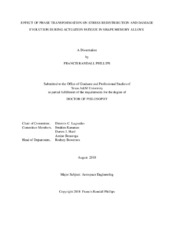| dc.description.abstract | Shape Memory Alloys (SMAs) are a unique type of metallic alloys which exhibit a reversible,
crystallographic phase transformation between austenite and martensite. SMAs have found applications
in a number of industries, including the biomedical, aerospace, and automotive industries.
However most of these applications are either non-critical or the SMAs have been severely overdesigned.
Part of the reason for these limitations is due to a lack of understanding in exactly how
these materials change throughout their lifetime.
In this work, various aspects related to the change in SMA components are studied throughout
their functional lifetime, both with respect to how the material changes within a single phase transformation
cycle, as well as how the internal microstructure evolves throughout the entire lifetime
of the SMA component. The first part of this work focuses on the effect of phase transformation
within a single phase transformation cycle by considering the redistribution of stresses during
phase transformation in notched cylindrical SMA bars under both pseudoelastic and thermal actuation
loading paths. These notches are tailored to achieve stress concentrations of varying magnitude
in order to see how different stress concentrations affect the phase transformation within a
single phase transformation cycle. The results indicate that the size of the notches have a direct impact
on the evolution of the phase transformation, changing from a linear propagation for shallow
notches to a spherical propagation for sharp notches. Furthermore, for notch sizes in which both
phase transformation propagation patterns exist, numerical results indicate that the stress redistribution
may lead to phase transformation reversal. Experimental efforts show general agreement in
terms of both surface level measurements as well as fracture surface analysis. In addition, neutron
diffraction experiments provide an additional level of validation for the numerical results due to
the ability to monitor the crystal structure of the experimental specimens during testing.
Beyond studying the effect of the phase transformation in a single cycle for a SMA with a stress
concentration, it is also necessary to consider the effect of the phase transformation throughout the
lifetime of a SMA actuator. In the second portion of this work, SMA actuators are analyzed using
X-Ray Computed MicroTomography in order to determine the evolution of internal damage as a
function of actuation fatigue life. The data shows that the internal damage evolves in a non-linear
manner, with a rapid nucleation of damage at the beginning of the fatigue life, followed by a slow
growth until close to the end of life, when damage coalesces and starts to grow exponentially. The
captured internal damage evolution behavior has been introduced into a SMA constitutive model
and results are presented showing that the proposed internal damage accumulation model is able to
capture the evolution of internal damage well throughout the fatigue lifetime, as well as predict the
cycles to failure for a SMA actuator. Based on an understanding of how internal damage nucleates
and grows throughout the actuation fatigue lifetime of a SMA component, it is in turn possible
to link this damage growth back to stress concentrations and therefore utilize this knowledge to
understand how stress will redistribute within each thermal actuation cycle for a SMA actuator. | en |


